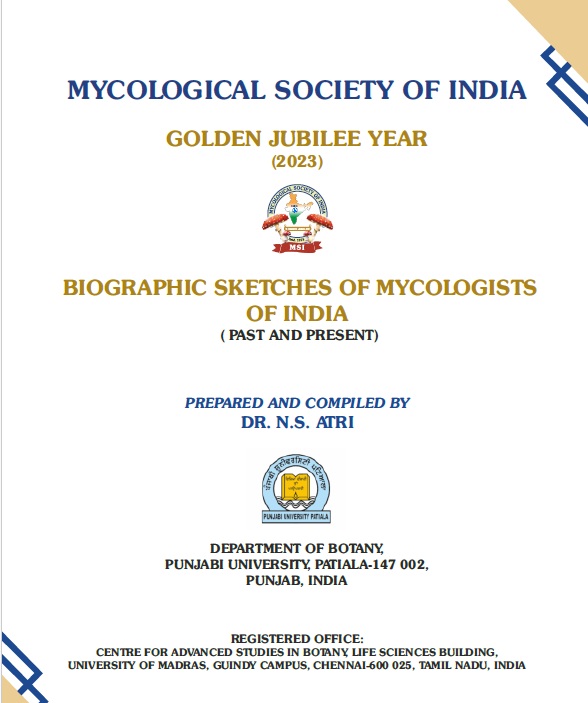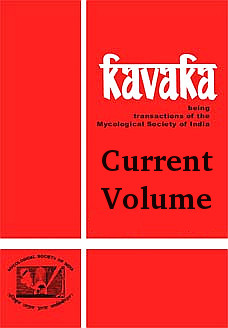| Sr. No. | Title & Author |
|---|---|
| 1 |
M.J. Thirumalachar : His multidimensional contributions to biological sciences and technology M. C. Srinivasan R.H. 17, Planet Millennium, Pimple Saudagar, Pune - 411 027, India Corresponding author email: srinivasanmc@gmail.com I am deeply honoured to be invited to contribute an article highlighting the scientific contributions of Dr. M.J.Thirumalachar for publication in an issue of KAVAKA dedicated to him in his Birth Centenary year (2014). I wish to place on record my appreciation of the decision of the Managing committee of Mycological Society of India to honour Dr. Thirumalachar as well as Prof. C.V.Subramanian on his 90th birthday in a similar manner. The opportunity to write this article has a profound emotional effect on me as a member of his family,- being his nephew who drew inspiration while being associated with him for two decades learning Mycology and Fungal Biotechnology. |
| 2 |
Role of mycology and mycologists in an era of industrial biotechnology Row House 17, Planet Millennium, Pimple Saudagar, Pune- 411 027, India Corresponding author email: srinivasanmc@gmail.com (Submitted in October, 2014; Accepted on December 5, 2014
ABSTRACT While reflecting on the life and scientific contributions of Dr. M.J.Thirumalachar, I am amazed at the way he grew up with the times and acquired the necessary skills to contribute meaningfully as a mycologist to the rapidly advancing discipline of Industrial Biotechnology. He was truly ahead of his times in his thinking and vision and if we take a leaf out of his book and evaluate its relevance in the context of today's requirements for innovative research and development ,we will definitely see the need for mycologists to gear up and get prepared for making meaningful contributions to Biotechnology in the twenty first century. I will attempt to review the role of mycology and mycologists in an era of industrial biotechnology and offer it as my humble tribute to Dr.Thirumalachar in the Kavaka publication commemorating his birth centenary. Keywords: Mycology, mycologist, fungal diversity, conservation, biotechnology |
| 3 |
Isolation of keratinophilic fungi from selected soils of The Gir Forest National Park and Wildlife Sanctuary, Gujarat, (India)
Corresponding author email: sunild2811@rediffmail.com
ABSTRACT Eighty samples were collected from six different sites in the vicinity of Gir Forest National Park and screened for the presence of keratinophilic fungi using hair baiting technique for isolation. Seventy three isolates were recovered and identified. The cultures were identified using macro- and micro morphological features. Their identification was also confirmed by the BLAST search of sequences of the ITS1-5.8S-ITS2 rDNA region against the NCBI/Genbank data and compared with deposited sequences for identification purpose. Ten species of seven genera were isolated, viz. Aphanoascus durus (2.50 %), Aphanoascus fulvuscence (5.00 %), Arthrographis kalrae (2.50 %), Auxarthron conjugatum (1.25 %), Chrysosporium indicum (16.25 %), Chrysosporium tropicum (6.25 %), Chrysosporium zonatum (3.75 %), Chrysosporium state of Ctenomyces serratus (7.50 %), Microsporum gypseum (12.50 %), and Trichophyton mentagrophytes (3.75 %). This study indicates that the soils of Gir Forest National Park may be significant reservoirs of certain keratinophilic fungi.
|
| 4 |
Taeniolina echinata-A new species of hyphomycetous (mitosporic) fungus from North India I. B. Prasher and Rajnish Kumar Verma* Department of Botany, Mycology and Plant Pathology Laboratory, Panjab University, Chandigarh 160014, India *Corresponding author email: vermarajnish1985@gmail.com
Taeniolina echinata sp. nov. Collected on dead leaf of Vanda sp. is described and illustrated from Chandigarh, North India. It is characterized by integrated, terminal or intercalary, polyblastic conidiogenous cells with catenate, pale olivaceous- brown, echinate, 1 to 3 septate conidia. A synoptic tabular account of all the species of the genus is provided for the comparison.
|
| 5 |
Influence of arbuscular mycorrhizal fungi and different salinity levels on growth enhancement and nutrient uptake of Gossypium arboreum L. Neetu Badda, Ashok Aggarwal*, Nisha Kadian and Navnita Sharma Mycology and Plant Pathology Laboratory, Department of Botany, Kurukshetra University, Kurukshetra, Haryana-136119, India
(Submitted in October, 2014; Accepted on December 2, 2014) ABSTRACT A pot experiment was conducted to see the effect of Arbuscular Mycorrhizal (AM) fungi, i.e., Glomus mosseae and Acaulospora laevis on cotton (Gossypium arboreum L.) in the presence of different salinity levels, i.e., 4 dSm-1, 8 dSm-1 and 12 dSm-1 with five replicates resulted in effective plant height, shoot and root biomass, root length, leaf area, root colonization, AM spore number, stomatal conductance, chlorophyll content, phosphorus content, nitrogen content, potassium content, sodium content, fibre yield and acidic and alkaline phosphatase activity. Under saline conditions, mycorrhizal inoculation significantly increased growth parameters as well as nutrient uptake of cotton plants over control. All growth parameters were found to be highest in dual combination of Glomus mosseae + Acaulospora laevis at 4 dSm-1 salinity level whereas sodium content was found to be highest in dual combination of Glomus mosseae + Acaulospora laevis at 8 dSm-1 salinity level. Overall results showed that AM colonization improves host plant mineral concentration and thereby increases the growth, yield and nutrient uptake of cotton plants by ameliorating the harmful effect of salinity stress. Keywords: Glomus mosseae, Acaulospora laevis, Gossypium arboreum, growth, mineral uptake, salinity stress |
| 6 |
Studies on endophytic fungi of commercially important tropical tree species in India. N. Senthilkumar, V. Mohan and S.Murugesan Institute of Forest Genetics and Tree Breeding, Forest Campus, R.S. Puram, Coimbatore-641002, Tamilnadu Corresponding author email: vmohan61@gmail.com
India targets to increase the forest cover to 33% by 2020 through programmes like Tree outside Forests (TOF) and Tree Cultivation in Private lands (TCPL). Cultivation of fast growing tree species for fuel and fodder in cultivable wastelands and uncultivable barren land has been encouraged. While planting efforts are on full swing to increase green cover, however, it is reported that about 1 million ha of forest area is being destroyed by insect pests annually, hence management of insect pests in domesticated forestry is much needed. Synthetic organic insecticides have emerged as major tools in pest management. About 3% of the total pesticides used in the world are utilized in India. It has been reported that about 2.5 million tons of chemical pesticides are used on crops each year. The toxicity of these chemicals results in residues in soil, water resources and crops that affect public health, hence there is a need to develop ecologically sound, environmentally safe and economically viable insect pest management strategies. Biological control has become an important tool for Integrated Pest Management (IPM). Use of microorganisms for the management of insect pests and diseases is risk free. Endophytic fungi are microorganisms that offer great-untapped effective solution for insect pest management. Several endophytic microbes are known to have anti-insect properties. The fungal endophytes protect their hosts from infectious agents and adverse conditions through secretion of bioactive secondary metabolites. In the present study, an attempt was made to isolate and identify the diversity status of endophytic fungi from commercially important tropical tree species viz.,Tectona grandis (Teak), Ailanthus excelsa (Ailanthus) and Gmelina arborea (Gmelina). A total of 18 species of endophytic fungi belonging to 13 genera and 58 strains were isolated from young and mature leaves of Teak, Ailanthus and Gmelina. Diversity and richness of endophytic fungi was found high in Teak followed by Ailanthus and Gmelina. Population of endophytic fungal species isolated from Teak, Ailanthus and Gmelina was found to be low and has not attained the expected population. It is also expressed in the rarefaction curve that it didn't reach asymptote curve, hence chances of encountering more number of species will be possible if the number of sampling unit increases. Of the 18 species, five species with one strain each were found to possess entomopathogenic significance based on preliminary bioassay studies. Future study will focus on biopesticidal properties of these fungi to develop novel biopesticide. Keywords: Endophytic fungi, rhizosphere, phyllosphere, tropical tree species. |
| 7 |
Biodegradation efficiency of Aspergillus awamori (MTCC-548) against Rose Bengal: A toxic dye for human corneal epithelium. Department of Biotechnology, Chaudhary Devi Lal University, Sirsa 125-055, India Corresponding author email: purewal.0029@gmail.com (Submitted in October, 2014; Accepted on December 9, 2014)
ABSTRACT
Keywords: Adsorption, Aspergillus awamori, biodegradation, industrial effluents, Rose Bengal.
|
| 8 |
Studies on the biology of Cordyceps militaris: A medicinal mushroom from North West Himalaya
Keywords: Cordyceps militaris, medicinal mushroom, entomopathogenic fungus, artificial cultivation, nutritional components.
|
| 9 |
Effect of bio-inoculants on seed germination and disease control of commercially important fast growing native tree species in nursery Division of Forest Protection, Institute of Forest Genetics and Tree Breeding, Coimbatore 641 002
|
| 10 |
Taxonomic study on species of Agrocybe (Strophariaceae, Agaricales) collected on dung from Punjab, India
Key words: Basidiomycota, clamp connections, coprophilous, systematics
|
| 11 |
Diversity and physiology of deep-sea yeasts: A review
1313, Tamra, Vainguinim Valley, Dona Paula, Goa 403 004. India.
Keywords: Culture-dependent approach, culture-independent approach, deep-sea habitat, elevated hydrostatic pressure, psychrotolerant yeast.
|
| 12 |
Lasiodiplodia indica -A new species of coelomycetous mitosporic fungus from India
(Submitted in November, 2014; Accepted on December 20, 2014)
ABSTRACT
Key words: Coelomycetes, conidiomata, ITS, phylogeny, taxonomy |
| 13 |
Genus Hyphodontia J. Erikss. in district Shimla (Himachal Pradesh) Maninder Kaur, Avneet Pal Singh * and G. S. Dhingra Department of Botany, Punjabi University, Patiala 147002
Key words: Basidiomycota, Agaricomycetes, Schizoporaceae, Hymenochaetales, North Western Himalaya. |
| 14 |
Potential of Pleurotus sajor caju to synthesize Silver nanoparticles and evaluation of antibacterial activity and their role as antibiotic activity enhancer
Key Words: Pleurotus sajor caju, silver nanoparticles, antibacterial activity, antibiotic activity enhancer |
| 15 |
Advances in applied mycology and fungal biotechnology*
Keywords: Agrochemicals, biodiversity, biotechnology, fungi, industrial products, pharmaceuticals. |
| 16 | Obituary |
| 17 | Book review |
























